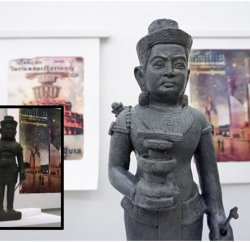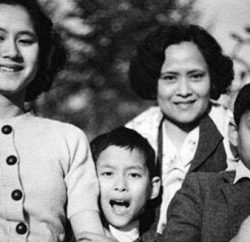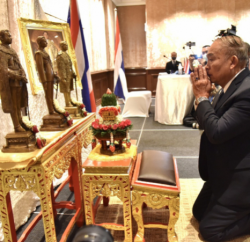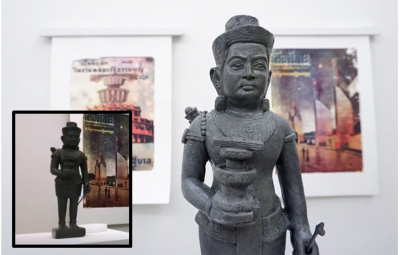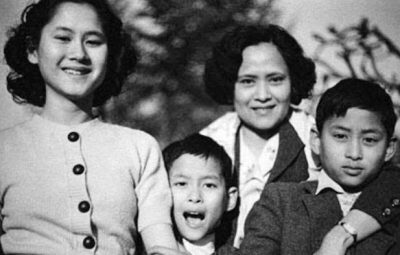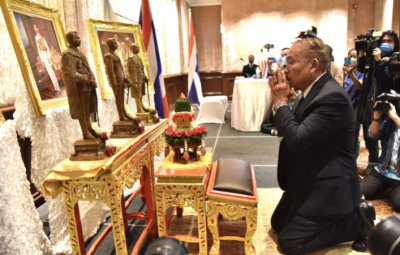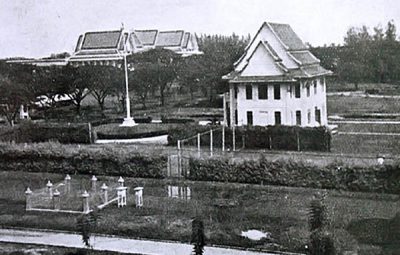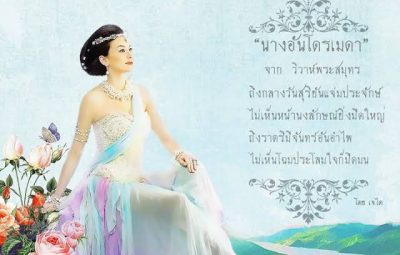นิตยสาร National geographic ประจำเดือนตุลาคม ค.ศ.1982 ได้เทิดทูนในหลวง โดยลงบทความเรื่อง Thailand’s Working Royalty หมายถึง “พระราชกรณียกิจใหญ่หลวงนัก” ท้ายสุดได้อัญเชิญพระราชนิพนธ์ของสมเด็จพระเทพรัตนราชสุดาฯ เรื่อง “เดินตามรอยเท้าพ่อ” โดยถ่ายทอด เป็นภาษาอังกฤษ แสดงถึงพระวิริยะอุตสาหะของพระบาทสมเด็จพระเจ้าอยู่หัวในการประกอบพระราชณียกิจ ซึ่งคนไทยทุกคนสมควรที่จะสำนึกในพระมหากรุณาธิคุณอันหาที่เปรียบมิได้
Thailand’s working Royalty
“พระราชกรณียกิจใหญ่หลวงนัก”
on National Geographic 1982 Photographs by JOHN EVERINGHAM
THE 48 MILLION SUBJECTS of Thailand’s King Bhumibol Adulyadej, Rama IX, regard the human summit of their . realm with awesome Asian reverence. Courtiers approach the royal presence on their knees, offering gifts on ceremonial trays. They speak a special, elaborate language of the court, never addressing the King directly, but putting their questions to the “coarse visible dust, fine invisible dust” beneath His Majesty’s feet. When a formal place communiqué announced that Queen Sirikit had suffered a broken ankle, the staff had to offer a translation into modern Thai. This year Thailand is celebrating the bicentennial of the reigning Chakri Dynasty with spectacular rituals that thread through seven centuries of history. Yet the pomp can obscure an important fact: Thailand has a strict constitutional monarchy with perhaps the world’s• hardest working royal family. The King and Queen have a restless court By car, by helicopter, and by foot, Their Majesties regularly travel to the 72 provinces of the realm. On these pages readers can accompany the energetic court entourage through the photographs of Australian John Everingham and royal interviews by Denis Gray, Associated Press bureau chief in Bangkok, and NATIONAL GEOGRAPHIC Assistant Editor Bart McDowell.
In profound deference to monarchy, an aide bears a royal gift at lower right. a couple approach on hands and knees Beyond such ceremonial duty, Thailand’s to be wed by King Bhumibol Adulyadej and rulers have brought royalty out of the palace Queen Sirikit in Bangkok’s Chitralada Palace; —into their people’s lives and problems.
A tradition revived: Like those that have borne Thai rulers since the 17th century, more than 50 royal barges, retired for 15 years, were meticulously restored for this year’s 200th anniversary of the reigning dynasty. Along the Chao Phraya River (above) the King and Queen ride beneath the canopy at right, with Princess Sirindhorn at their feet and Crown Prince Vajiralongkorn amidships.
Royal guards in an accompanying vessel bow to stay beneath the rulers as they pass (right); photographers, too, were denied higher vantage points. The barges echo smaller craft that have long carried travelers through riverine Bangkok, once known as the Venice of the East for its maze of lelongs, or canals. Many, however, have been filled and paved over as roads during the city’s explosive growth.
I THINK that the Thai people understand the use of tradition,” observes King Bhu-mibol Adulyadej. “Traditional doesn’t mean old-fashioned. Even the most mod-ern people have tradition. “They say that a kingdom is like a pyra-mid: the king on top and the people below. But in this country, it’s upside down. That’s why I sometimes have this pain around here.” The serious, scholarly face breaks into a smile as he points to his neck and shoulders. A National Assembly enacts all laws, but the Royal Thai Army is the most powerful force in Thai politics. Changes in govern-ment have come with usually bloodless coups. National unity is achieved, Thais agree, through the Theravada Buddhist faith, a high sense of patriotism (the word Thai means “free”), and the monarchy. But over the centuries the king’s role has changed greatly. Or as King Bhumibol puts it, “Monarchy in this country has al-ways been on the move.” And the traditional man on the move who
has reigned in Thailand since 1946 brings a singular perspective to his role. He was born in 1927 in Cambridge, Mas-sachusetts—the only monarch ever born on United States soil—while his father was studying medicine at Harvard University. Young Prince Bhumibol was schooled in Switzerland, where he studied both science and law and pursued such Western hobbies as fast cars and jazz clarinet. An automobile accident cost him his right eye, and it was during his convalescence that he fell in love with the daughter of a titled Thai diplomat, the present Queen Sirikit. The untimely deaths of his father and then of his older brother brought Prince Bhumibol to the throne of a nation occupied and exploited by the Japanese during World War II. Since the 1960s the king has rarely left Thailand. Pa-tiently, he has served as a constitutional monarch through eight coups d’etat and 11 different constitutions. He has intervened only in moments of crisis, as in 1973 when student demonstrations left more than 70 dead; the King’s compassion for the students
brought a quick change in government. For NATIONAL GEOGRAPHIC, King Bhumibol recently reviewed the two centuries of the Chakri Dynasty, candidly characteriz-ing the reign of each ruler: “Nine kings-I am the ninth. Each has a special characteristic. Rama I built the system of governing, of military security, of culture, et cetera. Rama II followed through, and as he got older he emphasized literature and art. He was himself an artist. Rama III set up the administration of the country. “Rama IV was a philosopher and scientist and brought in modern technology. He blended modern science with a traditional religious outlook. Rama IV-King Mong-kut, of The King and I fame-taught him-self English and Latin. He calculated everything and predicted an eclipse that he went to see. He set up modern Thailand, but it was during the reign of his son Rama V, King Chulalongkorn, that it blossomed. “King Chulalongkorn set up all the minis-tries and railroads and systems of education. “King Rama VI continued with more
Its splendor restored with gold leaf and the polish of thousands of hapds, the Grand Palace (left) sets the night ablaze during the bicentennial celebration last April. In 1782 the palace became the centerpiece of a new Thai capital called Krung Thep, “city of angels,” known outside Thailand as Bangkok. Its founder, Rama I, established the Chakri Dynasty that still reigns through King Bhumibol, Rama IX. Architect of Thailand’s first foreign policy from 1851 to 1868, King Monghut, or Rama IV (right), expanded trade with the West, but he held colonialism at bay. Thailand became a neutral buffer between British and French claims in Burma, Malaya, and Indochina. Monghut pioneered close contact between the rulers and the ruled by traveling the country as a barefoot monk, until becoming king at age 47. He was romanticized by “The King and I,” a musical now banned in Thailand for its historical liberties.
emphasis on foreign relations. He, too, was an artist. The seventh reign was unfortu-nate, because there was an international de-pression. Rama VII was in a difficult position; the treasury was nearly drained. He set up democracy, but the ones who wanted the democracy cut him short. He would have set up a real democracy in a few years instead of the government that was not well devised, not well studied. We still have the effect of it. “The eighth reign, my brother, had no time to do so many things- during and after World War II, a difficult time. But he set up, perhaps without knowing, the new kingship. The people had somebody to look on as a symbol. When he died he was 20, a young man with a good future. A new thing, because in the past kings were perhaps more sheltered. He was like raising a flag. But he also was cut short. “So I came, when I was 18 years old. Now 36 years ago, quite a long time. When I came to this function in the palace, the chairs and carpets had holes. The floor creaked.
The palace was crumbling down. It was just after the war, and nobody had taken care of things. I had to reconstruct. I don’t demolish. I put things together piece by piece. Slowly. For 36 years. So this reign is perhaps characterized with going step by step. Evo-lution. Looking at the good things of the past. Traditions perpetuated and trans-formed. That is the lesson: We take old traditions and reconstruct them to be used in the present time and in the future.”
FOR PUBLIC CEREMONIES in Bangkok, King Bhumibol is always dutiful and formal. Shaded by a purple umbrel-la, the King stands plumb-line straight, uniformed in white, sashed in gold as the symbol of his Chakri Dynasty. His ex-pression is unsmilingly serious and his
movements brisk and meticulous. He is not a glad-handing campaigner but the con-cerned father of his people, intense, iconic. In the tropical heat he moves among his subjects with complete control; only those close at hand can see that sweat drips from the King’s chin and hands, unacknowledged by any gesture*.
In this personal way the King himself hands each university graduate in the realm a diploma and each second lieutenant his commission.
Away from public view, the King’s routine includes less pomp but no less concern with duty. Take, for example, the moated residential Chitralada Palace in Bangkok. The kilometer-square palace grounds pro-ject the King’s interests, and seem more like an agriculture experiment station than a royal preserve.
Here His Majesty super-vises rice crops and the building of storage bins and silos in metal, wood, and con-crete. Ponds are stocked with varieties of fish from Japan. Technicians process milk products and demonstrate their skills for visitors. A forest project blends with land-scaping; royal elephants, peacocks, and rabbits feed nearby. To fill a low spot in a roadbed, workers use the rubble from a remodeled temple. “Nothing is wasted,” a palace workman notes proudly. The King sums up his Chitralada activity: “Everything is experimental.”
THE PALACE ITSELF seems less a monument than a family home. A children’s playhouse sits near a pond in the front grounds. The palace’s metal roof bristles with the King’s ham radio antennas. Inside, furnishings are turn-of-the-century solid and bear the cipher of Rama V, king from 1868 to 1910. Rooms are decorated with heavy draperies, the tusks of long-dead ele-phants, ancestral portraits, and reproduc-tions of favorite paintings like Sir Thomas Lawrence’s “Pinkie.” Attendants complain about mosquitoes that laze through open doors. The unpretentiousness of the palace reminds a visitor that descendants of a Thai monarch revert, after five generations, to the rank of commoner. The King himself is a most uncommon man, and his conversation spans a Renais-sance spectrum: irrigation systems, interna-tional balance of payments, minerals, even his own hobbies like photography and car-tography-“but I have stopped painting; it takes too much time,” he explains. He still plays several instruments and composes music. In fact a privately printed book lists 41 of the King’s compositions, among them “Hungry Men’s Blues” (“You’ll be hungry, too, if you’re in this band-Don’t you think that our music is grand?”), “Royal Guards March,” “Love Over Again,” and “Friday Night Rag.” Always the King’s conversation returns to his visits with individual Thais. “The Thai people are not military, but aware the country must be strong militarily. Once, in a province near Bangkok, a drunk man came up to me. The security people were not very happy about it, I understand.
He said he had been a soldier. He had served the country. His son would be a soldier also, that without military people our country wouldn’t be free like this. They say that drunk people do tell the truth. “Just last month I went to the south, and in one village a man told me that he has one daughter and one son. And he asked me, `Can Muslims go into the military school?’ I said, ‘Of course, if a boy is good, strong, and intelligent, he can apply to the military school.’ And I asked the man, ‘How old is your son?’ He said, ‘Six months old.’ ” The King laughs. “He wants his son to de-fend the country. He said, ‘We Muslims are real Thais.’ ” The King sees many forms of invasion: “The most modern way is to infiltrate and to take over the minds of the people. I call it mental warfare. To step into your head.” To avoid mental invasions a government must show sensitivity and patience.
Royal images: A floral arrangement catches the eye of King Bhumibol (above), long an avid photographer.
Like the matter of opium:
“We don’t deny that there is still opium grown in this country, but there’s a very small quantity. The problem of opium is the traffic through the country. The people who cultivate the opium poppy don’t get one-thousandth of the value. So we try to have a crop substitution. It takes many years just to begin. At first we went by car and by foot, then by helicopter, sometimes landing in the poppy fields. We must be careful because people don’t understand what is bad. ”
Once I walked for an hour to see one poppy field. The land looked bad, and the farmers said, ‘Yes, the land is exhausted-no fertilizer.’ We said we would give fertilizer if they would not grow opium but raise beans instead. The farmers asked time to take consultation, and after 15 minutes returned and said, ‘All right, we’ll take it.’ Well, next year we went back-half beans, half opium. And better results from beans, so they asked for more beans. Next year they raised only 25 percent opium. It diminishes like that. We have to be patient. If we just destroy the poppy, the people will be hungry and wonder
why we are against them. They could become insurgents. But it takes follow-up.” In their travels around Thailand, the King and Queen have faced danger from Muslim separatists as well as Communist in-surgents. In 1977, for example, in the southern province of Yala, two bombs exploded near the royal couple. “The danger?” muses the King. “The publicized danger is Communism. But the greed of our own people is more dangerous. If we clash too much among ourselves, we will become the slaves of what I call the new imperialism, be it Communist or dictator-ship or whatever.” His faith in the Thai people remains firm. “Thais seem to be happy-go-lucky but are quite strong. Our people are relaxed, not high-strung or stiff. They are hospitable-to strangers and to new ideas. The majority are Buddhist-and the Buddhists have never had a holy war. They are polite. Honorable politeness. They have courage but are not harsh-strong but gentle.”
..
But his favorite subject for the camera is his queen, Sirihit, whose beauty has captivated him since their marriage in 1950. Their palace often echoes to jazz played on saxophone or clarinet, another of the creative King’s talents.

WHILE KING BHUMIBOL performed his religious duties and meditations as a Buddhist monk in 1956, Queen Sirikit was named Regent of Thailand. Before the National Assembly she took an oath of allegiance echoing the King’s own coronation pledge: “We will reign with righ-teousness, for the benefits and happiness of the Siamese people.”
The Queen’s active role fits into the his-torical traditions of Thai women, who “nev-er had the feeling of being inferior to their menfolk,” as the Queen herself has noted. Her own work schedule would dismay most males. Traveling with the King to remote areas, Queen Sirikit encourages traditional crafts to supplement the income of rural peo-ple. In Phet Buri Province she launched a project to make handbags and sandals from jute and palm leaves. In Prachuap Khiri Khan Province the Queen got women to make artificial flowers. She revived the old art of making chao wang, clay dolls, and sent instructors to teach Ayutthaya women to weave cotton. Embroidery, fern-vine basketry, tie-dyeing, silverwork-Queen Sirikit encourages both the crafts and their sale in special shops.
On frequent trips abroad representing the King as a goodwill ambassador, she pro-motes the export of handwoven Thai silk; and at age 50, the arrestingly beautiful Queen Sirikit is herself an incomparable model for Thai fashions. She employs her organizational skills for the Thai Red Cross Society, for aid to refugee orphans, wound-ed soldiers, and flood victims.
Years ago, when an interviewer asked her favorite hobby, the Queen replied, “Look-ing after my children.” The three princesses and one prince are now grown. And the Queen helps bring them into more of the royal concerns: opening exhibits, meeting diplomats, shaking endless rows of extend-ed hands “for the benefits and happiness of the Siamese people.” The King’s physician, Dr. Chinda Snid-wongse, complains that “His Majesty works too hard.” And though the 54-year-old King jogs and does push-ups almost every day, the doctor would “like for him to take a va-cation each year.” People still worry about the time seven years ago that he fell seriously ill after visiting a dusty hilltribe village;
others speculate about the possibility that His Majesty might have an ulcer. Concern for the popular King reflects uncertainty over the royal succession. The el-dest daughter, Princess Ubol Ratans, married an American while studying in the U. S. and currently lives in California. The youngest daughter, Princess Chulabhorn, this year married a Thai commoner. Crown Prince Maha Vajiralongkorn, now 30 years old, has enthusiastically studied military science in Australia and the U.S.A.

but has inspired controversy regarding his own suit-ability for or interest in acceding to the throne. Observers have noted that some Thais are disturbed by the crown prince’s fascination with military matters and his seeming inattention to civilian pursuits. Others in the palace have described the prince’s family life as “not so smooth.” If the prince should remove himself from succession, there is a popular alternative in
Humble before inner strength that transcends tragedy, Queen Sirikit pays respect to a Buddhist monk who lost his limbs in an accident while drawing water from a well. She learned of the incident and quickly arranged a visit to the monastery while touring the rural north to promote development projects such as silkworm nurseries. The Queen also encourages cottage industries that include the weaving of distinctive fern-vine handbags.
Rating a silver platter, helmet and gloves are presented by aides to Crown Prince Vafiralonghorn, seated in the cockpit of an F-5E fighter (above). The prince, 30, ranks as a wing commander in the Royal Thai Air Force; duty in Australia and at Fort Bragg in the United States helped hint develop proficiency in flying. Outside the Temple of the Emerald Buddha, eagir hands donate funds to Princess Sirindhorn (facing page), 27, who organized the restoration of such shrines. The royal children include two other daughters, but of them all, Sirindhorn’s charisma makes her the apple of the public’s eye.
the unmarried Princess Sirindhorn, a bril-liant 27-year-old scholar who was years ago accorded a special dynastic title (Maha Chakri) by the National Assembly. More re-cently the parliament has revised royal law to permit, for the first time in Thai history, a woman monarch. Princess Sirindhorn accompanies the King on numerous remote journeys, experi-ences that inspired her to write a poem that rhymes in both French and Thai. Its title—”The Footstep of My Father,” seems porten-tous. At least, the princess makes a symbolic comment on the burdens of monarchy in Southeast Asia:
The Footsep of My Father
“ Through the dark jungle, very dense,
Which stretches out interminably , somber and immense…
I follow without stopping the footstep of my Father.
Oh Father, I am dying of hunger and I am tired.
Look! The blood is running from my two wounded feet…
Father! Will we arrive at our destination?
-Child!… On the earth there exists no place
Full of pleasure and comfort for you.
Our road is not covered with pretty flowers.
Go! Always,even if it breaks your heart.
I see the thornes prick your tender skin.
Your blood: rubies on the grass, near the water.
On the green shruberry, your tears dropped.
Diamonds on emerald, show their beauty.
For all the human race does not lose its courage
In the face of pain. Be tenacious and wise.
And be happy to have and ideal so dear.
Go! If you want to walk in the Footstep of your Father.”
เดินตามรอยเท้าพ่อ
“ ฉันเดินตามรอยเท้าอันรวดเร็วของพ่อโดยไม่หยุด
ผ่านเข้าไปในป่าใหญ่ น่ากลัว ทึบ
แผ่ไปโดยไม่มีที่สิ้นสุด มืดและกว้าง
มีต้นไม้ใหญ่เหมือนหอคอยที่แข้มแข็งพ่อจ๋าลูกหิวจะตายอยู่แล้วและเหนื่อยด้วย ดูซิจ๊ะ…
เลือดไหลออกมาจากเท้าทั้งสองที่บาดเจ็บของลูก
ลูกกลัวงู เสือ และหมาป่า
พ่อจ๋า…
เราจะถึงจุดหมายปลายทางไหม?
ลูกเอ๋ย… ในโลกนี้ไม่มีที่ไหนดอกที่มีความรื่นรมย์
และความสบายสำหรับเจ้า
ทางของเรามิได้ปูด้วยดอกไม้สวยสวย
จงไปเถิด แม้ว่ามันจะเป็นสิ่งที่บีบคั้นหัวใจเจ้า
พ่อเห็นแล้วว่า หนามตำเนื้ออ่อนอ่อนของเจ้า
เลือดของเจ้า เปรียบดั่งทับทิมบนใบหญ้าใกล้น้ำ
น้ำตาของเจ้าที่ไหลต้องพุ่มไม้สีเขียว
เปรียบดั่งเพชรบนมรกตที่แสดงความงดงามเต็มที่
เพื่อมนุษยชาติ จงอย่าละความกล้า
เมื่อเผชิญกับความทุกข์ให้อดทนและสุขุม
และจงมีความสุขที่ได้ยึดอุดมการณ์ที่มีค่า
ไปเถิด… ถ้าเจ้าต้องการเดินตามรอยเท้าพ่อ.”
From its earliest days, the Thai monarch was defined in scripture as Mahasammata, or a king of righteousness, “elected by the people.” Buddhist teachings of the ten king-ly virtues were supplemented by a quartet of qualities for an ideal monarch: a knowledge of food production, a knowledge of men, the means of winning the people’s hearts, and gentle words—all useful attributes for a Thai monarch in the late 20th century. King Bhumibol Adulyadej defines the problem of his realm: “Our country is rich. And strategic. So that if there is any struggle in the world, people want to get this country. And there’s always a struggle in the world. “We still stand here. We stand here for the good of the whole world.”
อ้างอิง ข้อมูลภาพจาก นิตยสาร National geographic ประจำเดือนตุลาคม ปี ค.ศ.1982














